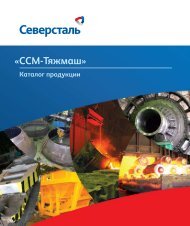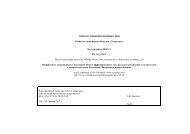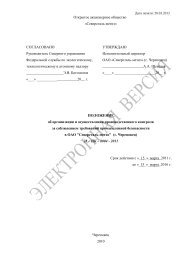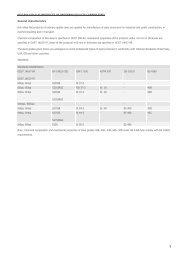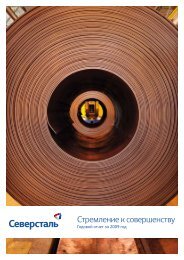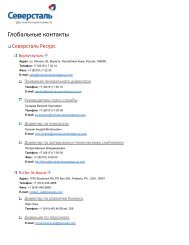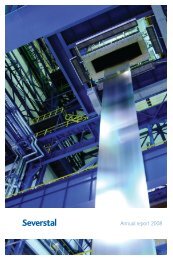Annual Report 2007 - Severstal
Annual Report 2007 - Severstal
Annual Report 2007 - Severstal
You also want an ePaper? Increase the reach of your titles
YUMPU automatically turns print PDFs into web optimized ePapers that Google loves.
Pipe industry<br />
In <strong>2007</strong>, the steel consumption in the pipe market was some<br />
5.6 million tonnes – without seamless pipes – which is 15–18%<br />
larger than it was in 2006.<br />
The pipe industry is divided into two segments: producers<br />
of pipes for the oil and gas industry and producers of pipes for<br />
the public utilities and housing sector.<br />
The oil and gas industry pipe market saw strong demand,<br />
with a large number of announced projects for construction of<br />
oil and gas pipelines, and by growing competition among the<br />
pipe producers.<br />
The public utilities and housing sector pipe market shows<br />
demand growth tied to more residential construction. The<br />
principal risk for the steel producers is in the growing consumption<br />
of plastic pipes.<br />
Machinery building<br />
In <strong>2007</strong> the size of the market for metal products for machinery<br />
building was approximately 6.7 million tonnes, which is 7–9%<br />
larger than in 2006. The market is characterised by stable<br />
consumption growth, especially in railway machinery, handling<br />
machinery, agricultural equipment, extracting and metallurgical<br />
equipment.<br />
Construction and Steel Service Centres<br />
In <strong>2007</strong>, this segment consumed almost 18 million tonnes.<br />
The segment grew by 13–14% in comparison with 2006, while<br />
construction industry growth was just over 10%. One important<br />
growth factor was the implementation of a top priority national<br />
project called “Accessible and Comfortable Housing for the<br />
Citizens of Russia”.<br />
Outlook for 2008<br />
The outlook for 2008 is positive for the steel and mining<br />
industries, particularly for the emerging markets and integrated<br />
steel producers.<br />
The global steel market is expected to be robust in most<br />
regions. Despite recent problems in the financial sector, the US<br />
market will benefit from reduced steel inventories, the weaker<br />
US dollar and increased ocean freight rates causing reduction<br />
of imports, while rising infrastructure spending and demand for<br />
durable goods from the emerging economies will sustain global<br />
steel demand growth.<br />
It is likely that European economic expansion will decelerate<br />
compared to <strong>2007</strong> given the higher euro exchange rate and the<br />
overall slowdown in the global financial sector.<br />
The global steel supply-demand balance is likely to<br />
remain tight given the few capacity additions planned for 2008<br />
outside China.<br />
A significant increase in raw materials prices will lead to a<br />
sharp rise in steel costs for non-integrated steelmakers. We expect<br />
these to rise by more than US$100/tonne compared to 2006.<br />
In this environment, global steel prices are expected to rise<br />
substantially in 2008.<br />
The key question is whether steel companies will be able to<br />
pass all the cost increases on to customers and sustain their own<br />
margins. Upstream-integrated steel producers from emerging<br />
regions are particularly well placed for 2008 given higher raw<br />
materials prices and strong demand from domestic economies.<br />
<strong>Severstal</strong> <strong>Annual</strong> <strong>Report</strong> <strong>2007</strong> 29



